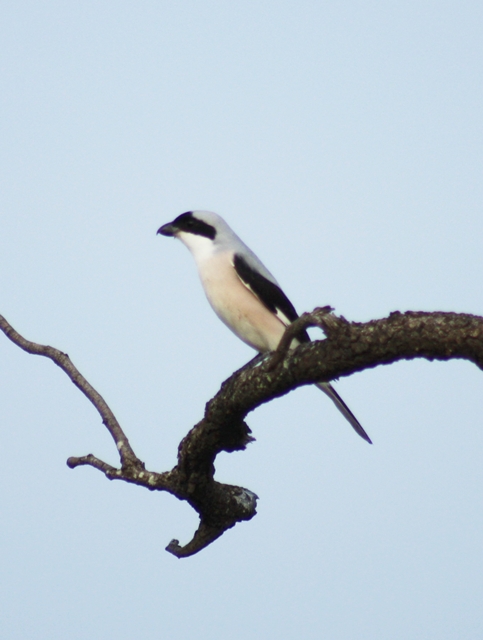https://africawild-forum.com/viewtopic. ... 29#p165229 Crimson Breasted Shrike
https://africawild-forum.com/viewtopic. ... 12#p167912 Orange Breasted Shrike
https://africawild-forum.com/viewtopic. ... 53#p166353 Lesser Grey Shrike
https://africawild-forum.com/viewtopic. ... 54#p166554 Magpie Shrike
https://africawild-forum.com/viewtopic. ... 66#p170366 Red backed Shrike
https://africawild-forum.com/viewtopic. ... 82#p165782 Retz’es Helmet Shrike
https://africawild-forum.com/viewtopic. ... 33#p173033 Southern White Crowned Shrike
https://africawild-forum.com/viewtopic. ... 18#p165818 White Crested Helmet Shrike
https://africawild-forum.com/viewtopic. ... 32#p168932 Common Fiscal
https://africawild-forum.com/viewtopic. ... 20#p168820 Grey Headed Bush Shrike
and not South African :
Chestnut Fronted Helmet Shrike
Souzas Shrike
White Tailed Shrike
True Shrikes (Laniidae) - BIRD OF THE MONTH JANUARY 2014
- Amoli
- Posts: 6032
- Joined: Fri Jun 01, 2012 4:30 am
- Country: South Africa
- Location: Kempton Park
- Contact:
True Shrikes (Laniidae) - BIRD OF THE MONTH JANUARY 2014
Pretoriuskop
Satara
Shingwedzi
20-30 Dec 2014
Satara
Shingwedzi
20-30 Dec 2014
- Amoli
- Posts: 6032
- Joined: Fri Jun 01, 2012 4:30 am
- Country: South Africa
- Location: Kempton Park
- Contact:
Shrike - BIRD OF THE MONTH JANUARY 2014 Copy Original
South Africa has 21 regularly occurring shrike species; including
3 skulking Tchagras,
6 colourful Bush-shrikes and
2 vociferous hoodlum Helmet-shrikes.
There are 3 Main families :
1.Laniidae – the biggest family
2.Prionopidae
3.Malaconotidae
1.The LANIIDAE family (the biggest family) has 4 Genes
• Genus: Lanius
Red-backed Shrike Lanius collurio
Souza's Shrike, Lanius souzae
Grey-backed Shrike Lanius tephronotus
Lesser Grey Shrike Lanius minor
Southern Fiscal, Lanius collaris
• Genus: Corvinella
Yellow-billed Shrike, Corvinella corvina
• Genus: Urolestes
Magpie Shrike, Urolestes melanoleucus
• Genus: Eurocephalus
Northern White-crowned Shrike, Eurocephalus rueppelli
Southern White-crowned Shrike, Eurocephalus anguitimens
2. FAMILY: PRIONOPIDAE
Helmet shrikes
3. FAMILY: MALACONOTIDAE
- which includes birds such as Bush-shrikes, Puffbacks, Tchagras, Boubous, Batises and Wattle-eyes
The Crimson-breasted Shrike (Laniarius atrococcineus)
The Bushshrikes are restricted to Africa.
FAMILY: CAMPERHAGIDAE - which is the cuckoo-shrikes and are not closely related to true shrikes.
The Australasian butcherbirds are not shrikes
3 skulking Tchagras,
6 colourful Bush-shrikes and
2 vociferous hoodlum Helmet-shrikes.
There are 3 Main families :
1.Laniidae – the biggest family
2.Prionopidae
3.Malaconotidae
1.The LANIIDAE family (the biggest family) has 4 Genes
• Genus: Lanius
Red-backed Shrike Lanius collurio
Souza's Shrike, Lanius souzae
Grey-backed Shrike Lanius tephronotus
Lesser Grey Shrike Lanius minor
Southern Fiscal, Lanius collaris
• Genus: Corvinella
Yellow-billed Shrike, Corvinella corvina
• Genus: Urolestes
Magpie Shrike, Urolestes melanoleucus
• Genus: Eurocephalus
Northern White-crowned Shrike, Eurocephalus rueppelli
Southern White-crowned Shrike, Eurocephalus anguitimens
2. FAMILY: PRIONOPIDAE
Helmet shrikes
3. FAMILY: MALACONOTIDAE
- which includes birds such as Bush-shrikes, Puffbacks, Tchagras, Boubous, Batises and Wattle-eyes
The Crimson-breasted Shrike (Laniarius atrococcineus)
The Bushshrikes are restricted to Africa.
FAMILY: CAMPERHAGIDAE - which is the cuckoo-shrikes and are not closely related to true shrikes.
The Australasian butcherbirds are not shrikes
Pretoriuskop
Satara
Shingwedzi
20-30 Dec 2014
Satara
Shingwedzi
20-30 Dec 2014
-
Klipspringer
- Global Moderator
- Posts: 5858
- Joined: Sat Sep 14, 2013 12:34 pm
- Country: Germany
- Contact:
Re: Shrike - BIRD OF THE MONTH JANUARY 2014
Laniidae
Urolestes melanoleucus Magpie Shrike 735
Eurocephalus anguitimens Southern White-crowned Shrike 756
Lanius souzae Souza's Shrike 734
Lanius collurio Red-backed Shrike 733
Lanius minor Lesser Grey Shrike 731
Lanius humeralis Northern Fiscal
Lanius collaris Southern Fiscal 732
Urolestes melanoleucus Magpie Shrike 735
Eurocephalus anguitimens Southern White-crowned Shrike 756
Lanius souzae Souza's Shrike 734
Lanius collurio Red-backed Shrike 733
Lanius minor Lesser Grey Shrike 731
Lanius humeralis Northern Fiscal
Lanius collaris Southern Fiscal 732
- Amoli
- Posts: 6032
- Joined: Fri Jun 01, 2012 4:30 am
- Country: South Africa
- Location: Kempton Park
- Contact:
Re: Shrike - BIRD OF THE MONTH JANUARY 2014
Lesser Grey Shrike Lanius minor .
Status
Fairly common non-br Palaearctic migrant, most arrive second half of Nov, and depart Mar-Apr. Habitat Arid and semi-arid open Acacia savanna; also found in dry broad-leaved woodland.
Food
Mainly insects, especially beetles. Call Harsh grating geer-geer… shrek-shrek-shrek-shrek… notes.
IDENTIFICATION:
20-22 cm; 45-47 g.
Sexes differ slightly in plumage coloration.
Ad male:
Frons and forehead black, joining black lores and ear coverts to form mask.
Crown and remainder of upper parts bluish grey.
Tail with central rectrices black..
Axillaries and underwing coverts white.
Throat white.
Remainder of underparts pinkish when fresh, white when worn.
Bill black, short and stubby.
Eyes brown.
Legs and feet brown to dark grey or blackish.
Ad female:
As male, but slightly duller. Mask smaller, with some paler feathers particularly on frons
In fresh plumage, underparts less pink.
Imm:
As adult, but paler; mask smaller, not extending over forehead.
Back more buff-grey (sometimes yellowish), underparts buffy white.
Upper and underparts sometimes with faint darker barring.
Wing coverts with pale edges.
Bill with pale, flesh-coloured base.
Juv:
Similar to adult, but paler; more buff above and yellowish below.
Upper parts finely barred; wing coverts edged buffish [Juvs not recorded in s Africa.]
Confusing species: Common Fiscal has crown to mantle black (not grey) and has prominent white scapulars.
Juv much browner than imm Lesser Grey Shrike, and much more heavily barred. [Melanism recorded9.]
Ref : Robert Bird Guide
Suikerbosrand Jan2012

KNP Dec 2012

Status
Fairly common non-br Palaearctic migrant, most arrive second half of Nov, and depart Mar-Apr. Habitat Arid and semi-arid open Acacia savanna; also found in dry broad-leaved woodland.
Food
Mainly insects, especially beetles. Call Harsh grating geer-geer… shrek-shrek-shrek-shrek… notes.
IDENTIFICATION:
20-22 cm; 45-47 g.
Sexes differ slightly in plumage coloration.
Ad male:
Frons and forehead black, joining black lores and ear coverts to form mask.
Crown and remainder of upper parts bluish grey.
Tail with central rectrices black..
Axillaries and underwing coverts white.
Throat white.
Remainder of underparts pinkish when fresh, white when worn.
Bill black, short and stubby.
Eyes brown.
Legs and feet brown to dark grey or blackish.
Ad female:
As male, but slightly duller. Mask smaller, with some paler feathers particularly on frons
In fresh plumage, underparts less pink.
Imm:
As adult, but paler; mask smaller, not extending over forehead.
Back more buff-grey (sometimes yellowish), underparts buffy white.
Upper and underparts sometimes with faint darker barring.
Wing coverts with pale edges.
Bill with pale, flesh-coloured base.
Juv:
Similar to adult, but paler; more buff above and yellowish below.
Upper parts finely barred; wing coverts edged buffish [Juvs not recorded in s Africa.]
Confusing species: Common Fiscal has crown to mantle black (not grey) and has prominent white scapulars.
Juv much browner than imm Lesser Grey Shrike, and much more heavily barred. [Melanism recorded9.]
Ref : Robert Bird Guide
Suikerbosrand Jan2012

KNP Dec 2012

Pretoriuskop
Satara
Shingwedzi
20-30 Dec 2014
Satara
Shingwedzi
20-30 Dec 2014
- Amoli
- Posts: 6032
- Joined: Fri Jun 01, 2012 4:30 am
- Country: South Africa
- Location: Kempton Park
- Contact:
Re: Shrike - BIRD OF THE MONTH JANUARY 2014
It is quite easy for me to spot the Lesser Grey Shrike from a distance as they seem to sit in the open. 
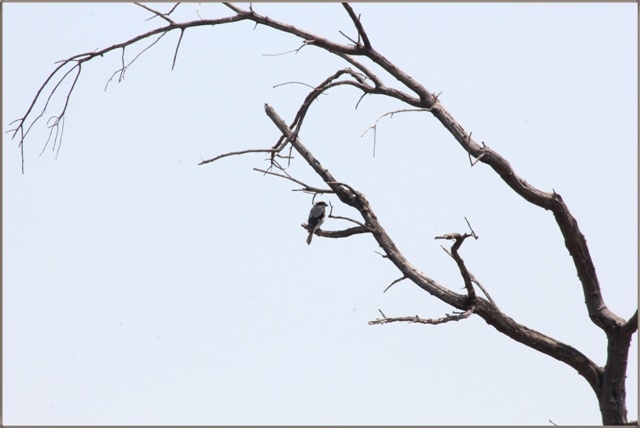
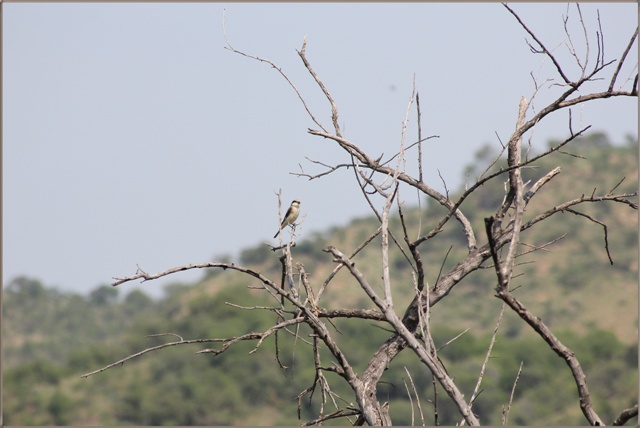
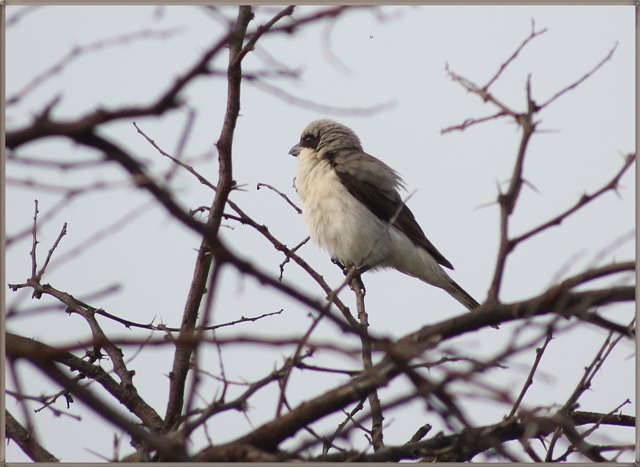

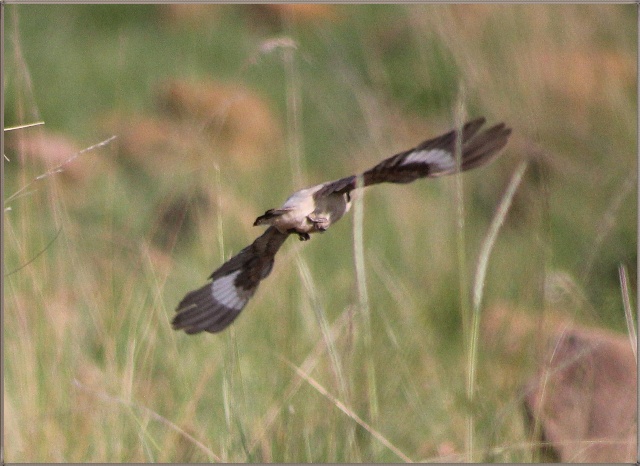





Pretoriuskop
Satara
Shingwedzi
20-30 Dec 2014
Satara
Shingwedzi
20-30 Dec 2014
- Super Mongoose
- Posts: 808
- Joined: Wed Nov 13, 2013 8:10 am
- Country: South Africa
- Location: Pretoria North
- Contact:
Re: Shrike - BIRD OF THE MONTH JANUARY 2014
Lesser Grey Shrike
March 2013, Tropic of Capricorn loop, KNP.
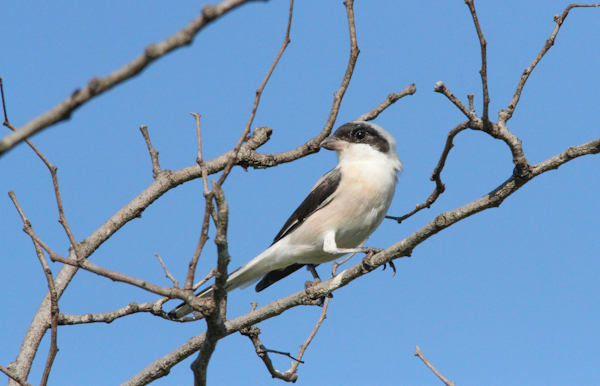
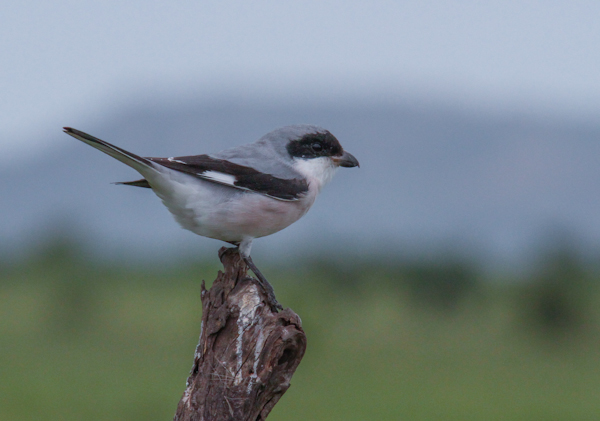
March 2013, Tropic of Capricorn loop, KNP.


Imagine RhiNOs!
We have to stand together to STOP the madness!
Please support a Rhino project!
We have to stand together to STOP the madness!
Please support a Rhino project!
- nan
- Posts: 26459
- Joined: Thu May 31, 2012 9:41 pm
- Country: Switzerland
- Location: Central Europe
- Contact:
Re: Shrike - BIRD OF THE MONTH JANUARY 2014
Lesser Grey Shrike
29.1.2012 - around Urikaruus

29.1.2012 - around Urikaruus

Kgalagadi lover… for ever
https://safrounet.piwigo.com/
https://safrounet.piwigo.com/
- Amoli
- Posts: 6032
- Joined: Fri Jun 01, 2012 4:30 am
- Country: South Africa
- Location: Kempton Park
- Contact:
Re: Shrike - BIRD OF THE MONTH JANUARY 2014
The Magpie Shrike (Urolestes melanoleucus), also known as the African Long-tailed Shrike, is a species of bird in the Laniidae family
Magpie Shrikes are large songbirds, around 43cm, but over half of that is made up by its tail.
They have black and white plumage.

They have extended black tails with white tips and wings.
The males and females are similar in size and plumage, although the female has white flanks that are lackng on the male.
The bill is black; eyes brown and legs and feet are black.

The magpie shrike can be heard singing all day long. They can often be heard singing songs back and forth to each other.
They are sociable creatures and are famous for their duets during breeding.
Breeding pairs are partners for life.
Preferring open woodland with plenty of acacia trees, the Magpie shrike is a fairly gregarious bird and is most commonly found in small groups of up to a dozen birds.
They will often perch in a conspicuous spot and call loudly.
They tend to feed on the ground, mainly on insects, small reptiles and even on mice and small birds. They will also hunt from a perch and hawk insects from the air.

They breed between March and July. The birds will hatch between three to five eggs during a breeding season. The chicks are cared for by both parents for approximately 28 days in the nest. The young birds remain in the breeding territory for up to a year in order to help parents raise their young.
Lifespan : 2.5 years
The scientific name for the Magpie shrike is Corvinella melanoleuca; Corvinella from the Latin for “a small crow” and melanoleuca from the Greek for “black and white”. Thus we have a small crow that is black and white. Well, the black and white is accurate, but I wouldn’t have thought it looked remotely like a small crow.
Magpie Shrikes are large songbirds, around 43cm, but over half of that is made up by its tail.
They have black and white plumage.

They have extended black tails with white tips and wings.
The males and females are similar in size and plumage, although the female has white flanks that are lackng on the male.
The bill is black; eyes brown and legs and feet are black.

The magpie shrike can be heard singing all day long. They can often be heard singing songs back and forth to each other.
They are sociable creatures and are famous for their duets during breeding.
Breeding pairs are partners for life.
Preferring open woodland with plenty of acacia trees, the Magpie shrike is a fairly gregarious bird and is most commonly found in small groups of up to a dozen birds.
They will often perch in a conspicuous spot and call loudly.
They tend to feed on the ground, mainly on insects, small reptiles and even on mice and small birds. They will also hunt from a perch and hawk insects from the air.

They breed between March and July. The birds will hatch between three to five eggs during a breeding season. The chicks are cared for by both parents for approximately 28 days in the nest. The young birds remain in the breeding territory for up to a year in order to help parents raise their young.
Lifespan : 2.5 years
The scientific name for the Magpie shrike is Corvinella melanoleuca; Corvinella from the Latin for “a small crow” and melanoleuca from the Greek for “black and white”. Thus we have a small crow that is black and white. Well, the black and white is accurate, but I wouldn’t have thought it looked remotely like a small crow.
Pretoriuskop
Satara
Shingwedzi
20-30 Dec 2014
Satara
Shingwedzi
20-30 Dec 2014
- nan
- Posts: 26459
- Joined: Thu May 31, 2012 9:41 pm
- Country: Switzerland
- Location: Central Europe
- Contact:
Re: Shrike - BIRD OF THE MONTH JANUARY 2014
Magpie Shrike - 2.3.2008 - Kruger


Kgalagadi lover… for ever
https://safrounet.piwigo.com/
https://safrounet.piwigo.com/



